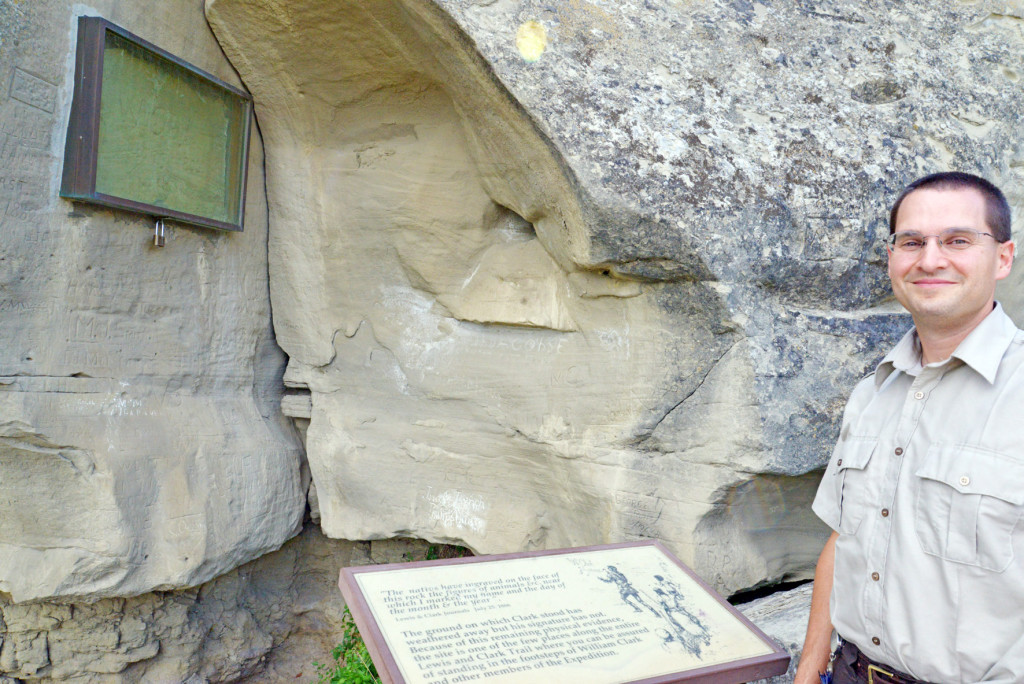POMPEYS PILLAR — Jeff Kitchens is going to enjoy Clark Days, from the early morning pancakes to the embers glowing in the evening campfire as he tells one last ghost story.
It’s his last day as manager of Pompeys Pillar National Monument before his next post as field manager in the BLM’s Prineville District in Oregon.
Kitchens loves working in the Bureau of Land Management because of the collaborative relationships it requires.
“What makes the job, and the BLM, so unique,” Kitchens said, is the land pattern — while Forest Service land usually has a contiguous boundary BLM land usually evolved from several sources and can form a checkerboard or atypical pattern.
Since BLM land can adjoin so many different owners and types of owners, including private, corporate, state and federal, it places “such an emphasis on partnering,” Kitchens said.
“Our culture really requires it.”
And he enjoys building those partnerships.
He relishes the somewhat unique path Pompeys Pillar took to become a national monument.
William Clark camped at the site in 1806, famously signing his name on the sandstone.
Decades later, in the 1880s, railroad officials “came along and protected the site,” which was in the railroad right of way, for historical significance.
They put up a grate to protect Clark’s signature, Kitchens said, but it wasn’t until much later, when the Foote family owned the site, when “they saw the benefit of the tourist attraction” and bringing people to the site for its unique importance as the only physical evidence of the Lewis and Clark expedition, “which is pretty remarkable and kind of cool.”
By the late 1980s, the Footes sold the property to the BLM, and in 2001 it became a national monument.
Today, it boasts excellent facilities, including a visitor center, but hasn’t lost the past, Kitchens said.
“It’s always been a very welcoming place,” he said, “but now it feels like it offers even more.”
Kitchens pointed out that Pompeys Pillar brings in a lot of people who are traveling through, see a sign or note on a map, and impulsively pull into the parking lot.
“So many people come here without any idea of what it is,” he said, and many express disbelief that they are seeing the only tangible thing left “on the trail” of Lewis and Clark. And Kitchens said the story of Clark’s journey on the Yellowstone during the time “isn’t told very much.”
Even the vaunted book, Stephen Ambrose’s “Undaunted Courage,” doesn’t tell much about Clark, although it’s a great book, Kitchens said.
Another neat thing about the way the BLM operates is that it places “a high emphasis on conservation, but not necessarily preservation,” Kitchens said.
This means that the 400 or so acres surrounding “The Rock” — outside the monument proper, which encompasses 51 acres — are used for a variety of purposes, including hunting, and the area’s agricultural uses continue.
The nearby grain elevator was not without controversy when it was built, he said, but operates without interfering with the monument, its activities or its visitors.
And Pompeys Pillar pulls them in, about 35,000 to 40,000 people every year, Kitchens said. Most of those, about 30,000 to 35,000, come between the first week of May and the last week of September.
Pompeys Pillar also hosts about 3,000 young people every year through school groups, the Boys and Girls Club and other organizations.
In his four years here, “my biggest surprise is so many people in Billings don’t come out to see Pompeys Pillar,” Kitchens said. “People lived in Billings all their lives, the surrounding area, haven’t been here.”
They should “come see our site,” he said. No, he corrected himself, “They should come out here and see their site.”

Jeff Kitchens, whose term as manager at Pompeys Pillar ends Saturday, is intrigued by years of efforts to preserve the signature carved in the rock face in 1806 by William Clark, seen here in a protective glass case. (Judy Killen photo)


